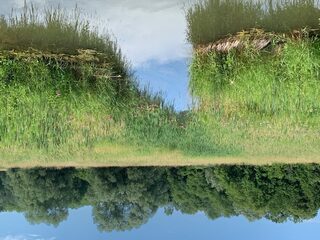
On July 23, Sierra Club Ontario had a walk on the tranquil, beautiful Seaton Trail which forms the battle line between the Rouge National Urban Park and the Pickering Airport Study Area. The walk went from the charming Victorian Gothic village of Whitevale, up to the Oak Ridges Moraine. Here, we turned back after seeing an indicator of good ecosystem health — a Pileated Woodpecker. We were also entertained by a soaring Red Tail Hawk and the sounds of Cardinals, Chickadees, and Wood Frogs.
Our field work demonstrated how towering Black Walnuts, with their chemical discharging roots, keep out an invasive exotic pest which plagues woodlands here — the Dog Strangling Vine.
To travel the beautiful 12.9-kilometer Seaton Trail along old growth forests of sugar maple, cedars, oaks; and hemlock and lush fern dominated understory, is a near urban adventure. The trail straddles land protected as the Rouge National Urban Park, as well as the Pickering Airport Reserve. It is the frontier of an important environmental battle line. It flows in the valley of Duffins Creek, which is either posed to be a miracle of environmental restoration or another sad casualty of urban sprawl.
Approximately west of the Seaton Trail is the 30,000-acre Rouge National Park. While to the east are 20,000 acres of lands designated by the Federal government as the Pickering Airport Reserve. Putting the study area here would help many species at risk which also benefit from the Rouge Park. It would for instance, extend the program whereby the Threatened Blanding Turtle is bred in the Rouge Zoo and released into the wild.
Activities on the study area lands, which now escape scrutiny of conservation biologists, would be properly reviewed if put into the Rouge National Park. Barns could be examined if they contained habitat for the now Threatened Barn Swallow, before they could be demolished. Farm leases could have provisions to protect rare species that are compatible with agriculture, such as the Barn Swallow, Bobolink and Meadowlark. Forest cover could be dramatically increased, helping Duffins Creek and becoming a park of a dramatic plan to stabilize the climate of Canada’s biggest city.
While excluded from the Rouge National Park, some of which the airport study lands on, are all owned by the federal government and are designated for a future industrial park to complement the airport. The latest federal government study on the Pickering Airport indicates that any construction for the airport would not commence until at least 14 years in the future (2026).
Having a possibility of the need in 14 years for some version of the Pickering Airport is based on a status quo federal transportation policy, which does not consider the threats posed by rising emissions from air transport (that will intensify dangers of human induced climate change from rising greenhouse gas emissions).
Any need for the Pickering Airport would vanish if Canada followed France’s example of strengthening rail transit. Through such methods, it has committed to phasing out short range air flights from the Greater Toronto region to Ottawa, Montreal, and Quebec City.
Although most of the airport reserve is in short term agricultural leases, there is a significant area that has wetlands, woodlands, and various streams.
In total, Land Over Landings, an environmental protection group dedicated to cancelling the Pickering Airport, has calculated that these areas in total amount to 1, 105 acres. Duffins Creek along the Seaton Trail north of a control dam at Whitevale, has the highest standards of environmental quality, with a self-supporting population of native Brook Trout. Development of the airport and adjacent industrial land could through storm water pollution destroy trout habitat. It would unleash toxins used as de-icing fluids for airports.
To experience the Seaton Trail is to understand why it is worthwhile being engaged in difficult struggles to ensure good land use planning and ecological restoration in Ontario. The trail gives a glimpse of the old growth Carolinian forest wonders that could, if given sensible use of public lands, dominate a 50,000 acre Rouge National Urban Park.


Photos:
#1 Seaton Trail, 2022.
#2 John Bacher playing the flute, Seaton Trail, 2022.
#3 Marsh off of West Duffins Creek, 2022.
